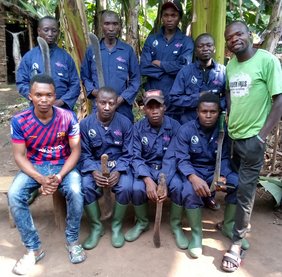Sarambwe under Occupation
Categories: Journal no. 69, War, Conflicts, Democratic Republic of the Congo, Sarambwe, Mountain Gorilla
Involving the population in conservation
Conservation and protection of biodiversity in eastern Democratic Republic of the Congo are subject to guesswork regarding the future and the survival of the fauna and flora. The different front lines and generalised fights, mainly in the Masisi and Rutshuru territories, pose a threat to conservation activities in the Virunga National Park and the Sarambwe Nature Reserve; these two protected areas are exposed to serious risks of destruction which could reach a point of no return. The displacement of thousands of people who are fleeing the conflicts without any assistance provided by the authorities has led to the destruction of the Virunga National Park's forest: people cut down trees for timber and to produce charcoal and prepare land for crop cultivation. As an example, the southern part of the park lost 964 hectares of forest between June and November 2023 (Global Forest Watch, November 2023). As of today, the total impact of the war on the fauna is still unknown.
Besides displacements, in most places with no conflict, the local population is asking for land under the hidden influence of politicians which leads to encroachments of protected zones and to animosity towards agents working in these zones. This was the case for the trackers in the Sarambwe Reserve in April 2023. This situation forced us to set up a system of rotation between members of the community, involving more of them in tracking activities. The first system of rotation excluded any person who had ever poached or cultivated in the reserve. As a result, these rejected community members became embittered and the system of rotation only worked for two turns.
Seeing the M23 rebellion progressing on the Kiwanja-Ishasha road was a terrible blow for us and caused great concern for the future of the Sarambwe Nature Reserve, located half way between Kiwanja and Ishasha (a border post with Uganda). These developments took place during two different stages, the first stage being in December 2023: rebels progressed from Kiwanja up to Nyamilima (a village located 40 km from Kiwanja and 20 km before reaching Ishasha) but then later on were forced to retreat to Kiwanja following numerous deadly ambushes on the occupied stretch. At this time of events all loyalist military had already left the zone. After the M23 retreat, Wazalendo, patriotic militias (including former Mai Mai rebels and others) settled in the ranger post in Sarambwe.
Being the only armed force, they started asking people to get firewood from the reserve for them. They also wanted to escort trackers in the reserve saying it was to protect them.
Under the influence of former poachers, some Wazalendo started to poach and gave the trackers an evil eye. One time, they went hunting with villagers who did not know the location of the boundary. They crossed to Uganda where they were arrested by Ugandan military, then released after some talks with the Congolese army. The trackers were scared and left their post to relocate to villages. The coordination of their activities was now planned from the chief tracker's village. Thanks to the long-lasting collaboration with the local population in the implementation of micro development projects, people were now giving useful information for the protection of the reserve. Fortunately, once informed, the Director and Chief Assistant of the Virunga National Park and the Eastern Sector Chief sensitized the Army Chief who formally forbid the Wazalendo rebels from poaching and attacking the trackers.
In November 2023, trackers leaving the forest after their duty were chased by former embittered poachers and young people who claimed to be leaders. With the Chief Conservationist of the eastern sector of the Virunga National Park and his Communal Conservationist, we carried out surveys and research. It turned out these young people and the poachers were jealous of the trackers claiming that they too had lost land in the reserve and therefore had the right to get jobs, along with other local people.
Today the Sarambwe Nature Reserve hosts four villages including a total of 810 households. Most of the population has relocated to Uganda or to towns like Rutshuru and Goma. In an attempt to palliate the demands of these embittered persons, we met with the chiefs of the four villages and came to an agreement that trackers will come from these villages working alternately in shift teams of 10 for a rotation period of 2 months, without excluding those who had carried out destructive activities as long as they do not repeat their acts. At the moment, everything is going well and any trespasser in the reserve is immediately reported by the population. Currently, there are no worries of destruction concerning the forest of Sarambwe by cutting down timber, making charcoal or poaching.
At the beginning of August 2024, the M23 rebels resumed the fights. They progressed rapidly and in only one week they took control of the road from Kiwanja up to Ishasha, the border post with Uganda. Just before they reached Sarambwe, the Wazalendo, who were occupying the ranger post, left taking with them all trackers' goods still in the post: tarpaulins, sauce pans, solar panels, phones, chargers, extensions and mattresses; they also staved in four doors out of the five in the ranger post.
Four days after the capture of Ishasha, M23 carried out controls in the surrounding areas of Sarambwe and advised the population to stay calm. The trackers' duties are going well - however, they fear that some Wazalendo could be hiding in the forest around Sarambwe disguised as civilians.
Claude Sikubwabo Kiyengo

